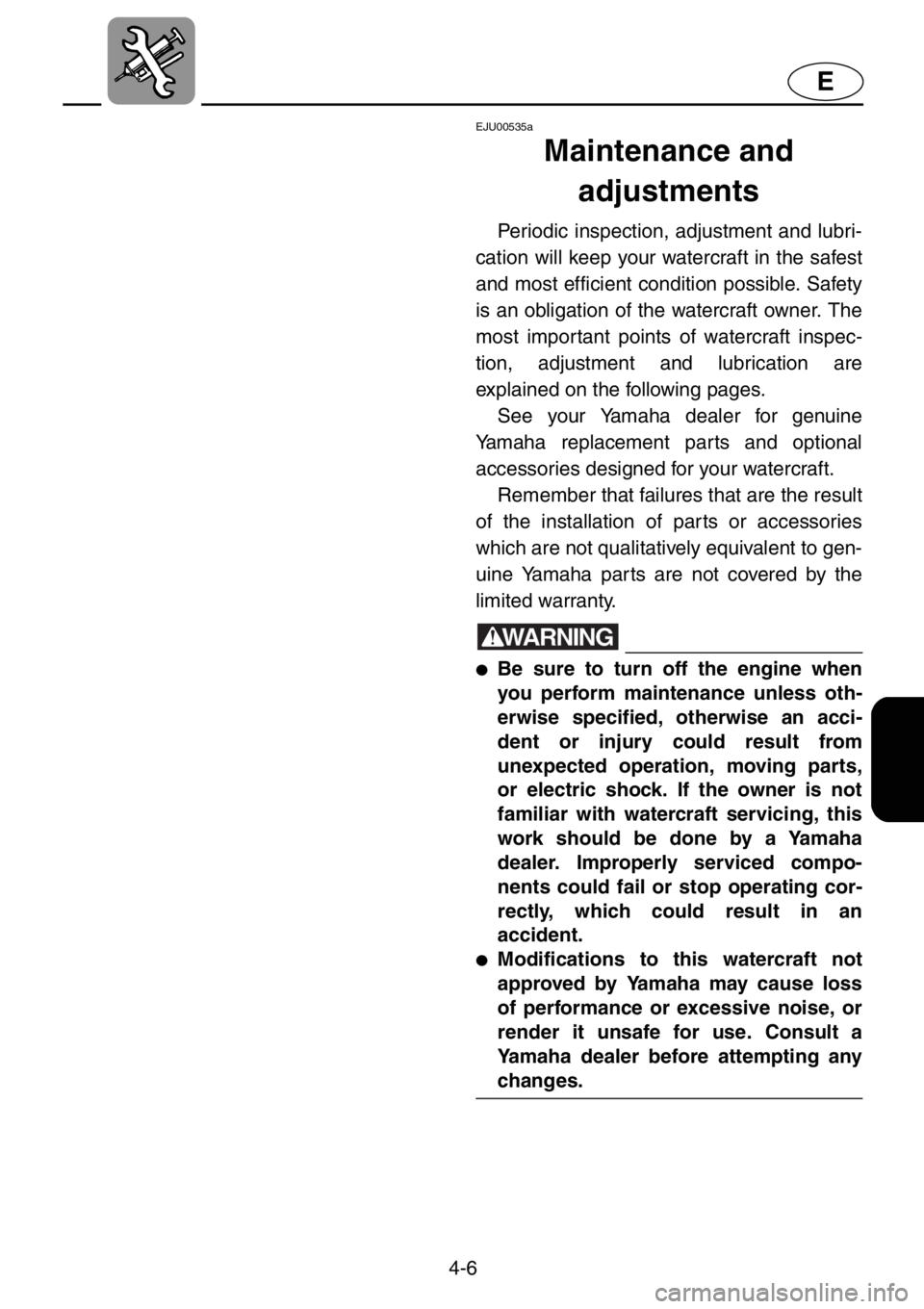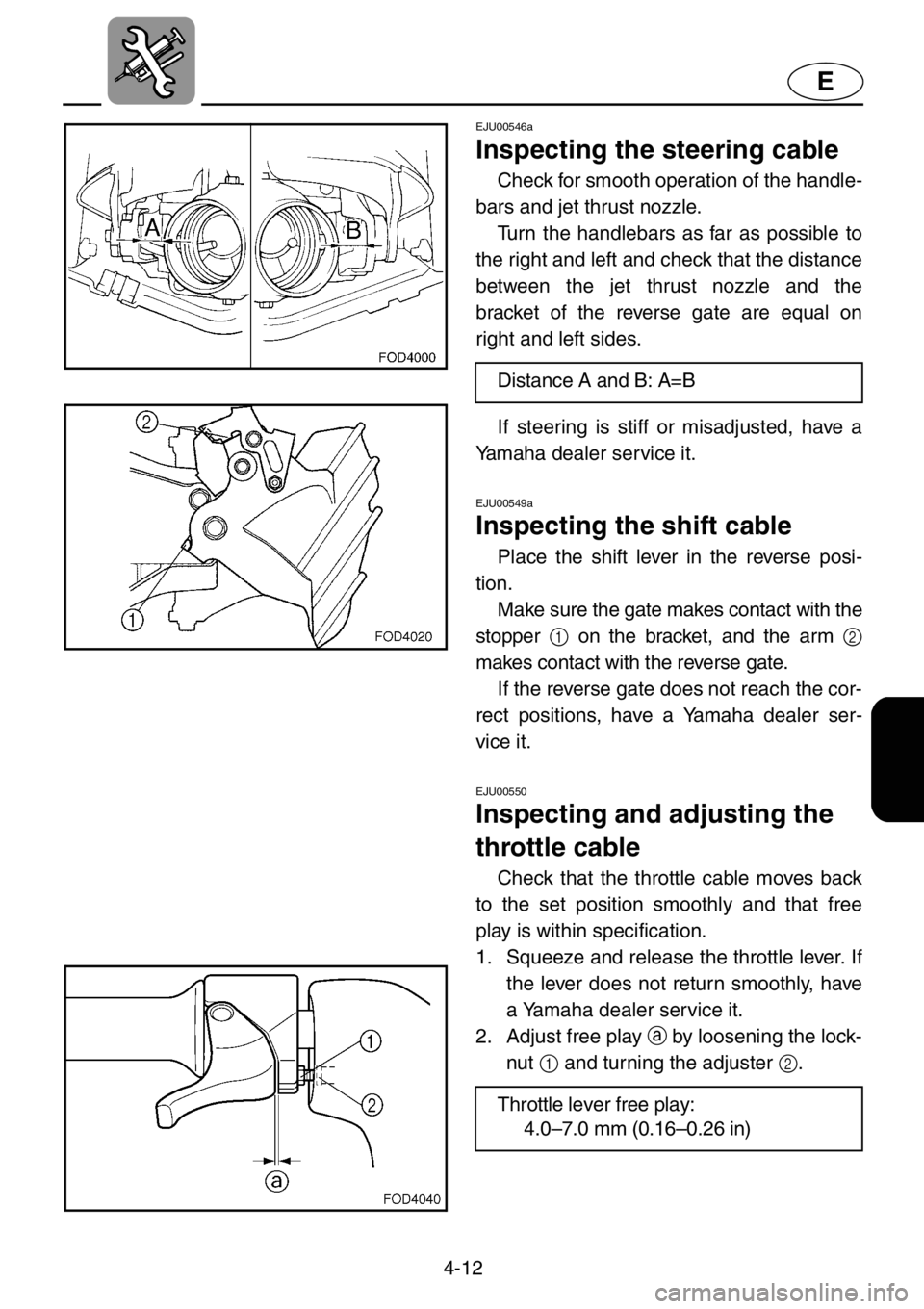Page 42 of 131

2-17
E
EJU00366
Engine overheat warning
system
The model has an overheat warning
device. If the engine starts to overheat, the
warning light, indicator and “W.TEMP” on
the meter begin to blink and the buzzer
sounds intermittently. If this happens,
reduce the engine speed and return to
beach at low speed. If there is no water dis-
charge at the cooling water pilot outlet while
the engine is running, check the jet intake
and impeller for clogging.
WARNING
Before attempting to remove weeds or
debris from the intake grate or impeller,
shut the engine off and remove the clip
from the engine shut-off switch. Severe
injury or death could result from coming
in contact with the rotating parts of the
jet pump.
CAUTION:
●Return to shore at low speed if the
overheat warning indicator and buzzer
are on, and the display shows
“W.TEMP.” If you ignore these signals,
the engine will stop running and can-
not be restarted until the exhaust sys-
tem cools.
●Have your watercraft inspected and
serviced by a Yamaha dealer if the
engine stopped due to overheating.
Page 94 of 131
4-1
E
EJU00516a
Storage
WARNING
Always place the fuel cock knob in the
“OFF” position when storing the water-
craft, otherwise fuel could leak out into
the engine or engine compartment,
which would create a fire hazard.
Storage for prolonged periods of time,
such as winter storage, requires preventa-
tive maintenance to ensure against deterio-
ration. It is advisable to have the watercraft
serviced by a Yamaha dealer prior to stor-
age. However, the following procedures can
be performed by the owner.
EJU00913a
Flushing the cooling system
Flushing the cooling system is essential
to prevent the cooling system from being
clogged with salt, sand, or dirt.
CAUTION:
●Do not supply water to the cooling
water passages when the engine is not
running. The water could flow back
through the muffler into the crankcase
causing severe engine damage.
●Do not run the engine for more
15 seconds without supplying water,
otherwise the engine may overheat.
Page 99 of 131

4-6
E
EJU00535a
Maintenance and
adjustments
Periodic inspection, adjustment and lubri-
cation will keep your watercraft in the safest
and most efficient condition possible. Safety
is an obligation of the watercraft owner. The
most important points of watercraft inspec-
tion, adjustment and lubrication are
explained on the following pages.
See your Yamaha dealer for genuine
Yamaha replacement parts and optional
accessories designed for your watercraft.
Remember that failures that are the result
of the installation of parts or accessories
which are not qualitatively equivalent to gen-
uine Yamaha parts are not covered by the
limited warranty.
WARNING
●Be sure to turn off the engine when
you perform maintenance unless oth-
erwise specified, otherwise an acci-
dent or injury could result from
unexpected operation, moving parts,
or electric shock. If the owner is not
familiar with watercraft servicing, this
work should be done by a Yamaha
dealer. Improperly serviced compo-
nents could fail or stop operating cor-
rectly, which could result in an
accident.
●Modifications to this watercraft not
approved by Yamaha may cause loss
of performance or excessive noise, or
render it unsafe for use. Consult a
Yamaha dealer before attempting any
changes.
Page 100 of 131
4-7
E
Owner’s/Operator’s Manual
and tool kit
It is advisable always to carry the Owner’s/
Operator’s Manual and tool kit with you
whenever you use the watercraft. For your
convenience, a storage compartment 1 is
provided on the watercraft for the manual
and tool kit.
NOTE:
To protect these materials from water dam-
age, it would be a good idea to put them in a
waterproof bag.
The service information included in this
manual is intended to provide you with the
necessary information for completing your
own preventive maintenance and minor
repairs. The tools provided in the tool kit 2
are sufficient for this purpose. However, a
torque wrench may also be necessary to
tighten nuts and bolts.
Page 103 of 131
4-10
E
EJU00538
Fuel filter
This watercraft is equipped with a one-
piece, disposable fuel filter 1. The fuel filter
should be replaced once a year or after
every 200 hours of operation, or if water is
found in the filter. Have a Yamaha dealer
replace the fuel filter if necessary.
WARNING
Do not try to replace the fuel filter your-
self. An incorrectly installed filter can
leak gasoline, which could lead to fire or
explosion. If necessary, have a Yamaha
dealer replace the fuel filter.
EJU00540
Fuel tank
Check the fuel tank 1 for leakage or
water in the tank. If water is found in the fuel
system or if the fuel tank needs to be
cleaned have a Yamaha dealer service the
watercraft.
Page 104 of 131
4-11
E
EJU00544
Inspecting the oil injection
system
Check the oil injection system for leakage,
cracks, or malfunctions. If necessary, have a
Yamaha dealer repair the oil injection sys-
tem.
Check:
●Oil tank for damage, cracks or leakage.
●Oil tank for water or dirt.
●Oil hose and joint for damage or cracks.
●Oil filter for dirt.
●Oil pump for leakage.
Oil tank
Check the oil tank for leakage or water in
the tank. If water is found in the oil injection
system or if the oil tank needs to be cleaned
have a Yamaha dealer service the water-
craft.
Oil filter
Check the oil filter for dirt and clogs. If the
oil filter is clogged, remove it from the oil
tank together with the oil level sender and
clean it.
Page 105 of 131

4-12
E
EJU00546a
Inspecting the steering cable
Check for smooth operation of the handle-
bars and jet thrust nozzle.
Turn the handlebars as far as possible to
the right and left and check that the distance
between the jet thrust nozzle and the
bracket of the reverse gate are equal on
right and left sides.
If steering is stiff or misadjusted, have a
Yamaha dealer service it.
EJU00549a
Inspecting the shift cable
Place the shift lever in the reverse posi-
tion.
Make sure the gate makes contact with the
stopper 1 on the bracket, and the arm 2
makes contact with the reverse gate.
If the reverse gate does not reach the cor-
rect positions, have a Yamaha dealer ser-
vice it.
EJU00550
Inspecting and adjusting the
throttle cable
Check that the throttle cable moves back
to the set position smoothly and that free
play is within specification.
1. Squeeze and release the throttle lever. If
the lever does not return smoothly, have
a Yamaha dealer service it.
2. Adjust free play a by loosening the lock-
nut 1 and turning the adjuster 2. Distance A and B: A=B
Throttle lever free play:
4.0–7.0 mm (0.16–0.26 in)
Page 106 of 131
4-13
E
EJU00551
Inspecting the QSTS
mechanism
Check that the shift lock lever moves back
to the lock position smoothly, that the QSTS
selector locks and unlocks properly, and that
the jet thrust nozzle moves up or down.
1. Squeeze and release the shift lock lever.
2. Check that the QSTS selector locks
when the lever is released.
3. Check that the selector turns smoothly
when the lever is squeezed and held in
place.
4. Check that the angle of the jet thrust
nozzle changes when the selector is
shifted from neutral to bow-up or bow-
down.
If the mechanism does not work properly,
have a Yamaha dealer service it.